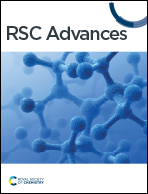Study of the molecular interaction of a phosphonium-based ionic liquid within myo-inositol and non-steroidal anti-inflammatory drugs
Abstract
Ionic liquids (ILs) can be used as carriers and solubilizers as well as for increasing the effectiveness of drugs. In the present investigation, the micellar properties of phosphonium-based ionic liquids (PILs) such as trihexyltetradecylphosphonium bis(2,4,4-trimethylpentyl)phosphinate ([P666(14)][THPP]) and the effect of carbocyclic sugar-based myo-inositol (MI) and non-steroidal anti-inflammatory drugs (NSAIDs), i.e. ibuprofen (IBU) or aspirin (ASP), on the PIL micellar system were studied using surface tension, conductivity, colorimetry, viscometry, FTIR, and dynamic light scattering (DLS) at a temperature of 299 ± 0.5 K. The critical micelle concentrations (CMCs), particle size, zeta potential, and various interfacial parameters were also included i.e., efficiency of adsorption (pC20), surface tension at CMC (γCMC), minimum surface area per molecule (Amin), surface pressure at CMC (πCMC), maximum surface excess concentration (Γmax), and various thermodynamic parameters, such as standard Gibbs free energy of adsorption  , standard Gibbs free energy of micellization per alkyl tail
, standard Gibbs free energy of micellization per alkyl tail  , standard Gibbs free energy of the air–water interface (ΔG(s)min), standard Gibbs free energy of transfer
, standard Gibbs free energy of the air–water interface (ΔG(s)min), standard Gibbs free energy of transfer  , and standard Gibbs free energy of micellization
, and standard Gibbs free energy of micellization  . The adsorption and micellization characteristics became more spontaneous, as shown by the more negative values of
. The adsorption and micellization characteristics became more spontaneous, as shown by the more negative values of  and
and  . Viscosity-based rheological properties were calculated for various PIL + MI and PIL + MI + NSAID systems. According to the DLS data, the PIL (Z = 316.4 nm) micellar system generates substantially bigger micelles in an aqueous solution of MI + ASP (Z = 801.7 nm) than in MI + IBU (Z = 674.7 nm). FTIR spectroscopy revealed the interactions of PIL with MI + ASP and MI + IBU, where it was observed that MI + IBU shows good agreement with the PIL system compared to MI + ASP. The current research will have effects on pharmaceutical sciences, molecular biology, and drug delivery.
. Viscosity-based rheological properties were calculated for various PIL + MI and PIL + MI + NSAID systems. According to the DLS data, the PIL (Z = 316.4 nm) micellar system generates substantially bigger micelles in an aqueous solution of MI + ASP (Z = 801.7 nm) than in MI + IBU (Z = 674.7 nm). FTIR spectroscopy revealed the interactions of PIL with MI + ASP and MI + IBU, where it was observed that MI + IBU shows good agreement with the PIL system compared to MI + ASP. The current research will have effects on pharmaceutical sciences, molecular biology, and drug delivery.



 Please wait while we load your content...
Please wait while we load your content...